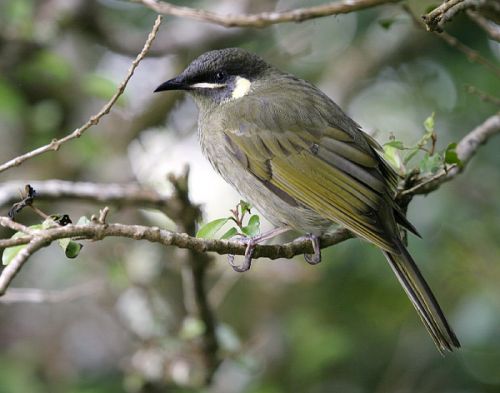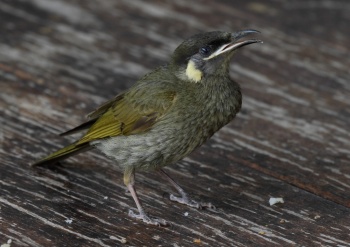- Meliphaga lewinii
Identification
19–21·5 cm (7½-8½ in)
- Dark greenish grey
- Creamy-yellow gape
- Large, yellowish crescent-shaped ear patches
- Black bill
- Bluish-grey eye
Young birds are similar but have brown eyes.
Flight
In flight, shows pale yellow edges to the flight feathers.
Distribution
Taxonomy
Subspecies
There are 3 subspecies[1]
- M. l. amphochlora:
- North East Queensland (Lloyd Bay to Cooktown)
- M. l. mab:
- East Queensland (Mossman to Fitzroy River)
- M. l. lewinii:
Habitat
Wet sclerophyll forests, rainforest including dense undergrowth at the forest edge and open woodland.
Behaviour
Diet
Their diet consists of a wide variety of fruits, nectar, insects, spiders and molluscs. They forage at all levels.
Breeding
The nest is a large cup of vegetation and other materials, bound together with spider's web. It is lined with soft material. The clutch consists of 2-3 oval eggs which are incubated for about 14 days. The young birds leave the nest after a further 14 days.
References
- Clements, J. F., T. S. Schulenberg, M. J. Iliff, D. Roberson, T. A. Fredericks, B. L. Sullivan, and C. L. Wood. 2017. The eBird/Clements checklist of birds of the world: v2017, with updates to August 2017. Downloaded from http://www.birds.cornell.edu/clementschecklist/download/
- Handbook of the Birds of the World Alive (retrieved Oct 2017)
- Wikipedia
Recommended Citation
- BirdForum Opus contributors. (2025) Lewin's Honeyeater. In: BirdForum, the forum for wild birds and birding. Retrieved 3 April 2025 from https://www.birdforum.net/opus/Lewin%27s_Honeyeater
External Links
GSearch checked for 2020 platform.1





